Due to its prevalence, most IT technicians are comfortable working with ethernet cables. IT technicians who are studying for the Network + or CCNA or have some basic experience in the field would be capable of cutting and crimping their ethernet cables. However, few have experience working with fiber. IT classes and certifications touch on how to configure straight-through and crossover cables while only giving a brief mention of the theoretical concepts associated with fiber. Any technician experienced with ethernet would find it daunting to show up to a new project only to realize their ethernet knowledge will not directly lend itself to understanding or configuring fiber. Ethernet is not going anywhere anytime soon; however, implementing fiber has become more viable than ever.
This post aims to introduce technicians to fiber optics such that they would be prepared to operate in this alternative environment.
The Technology
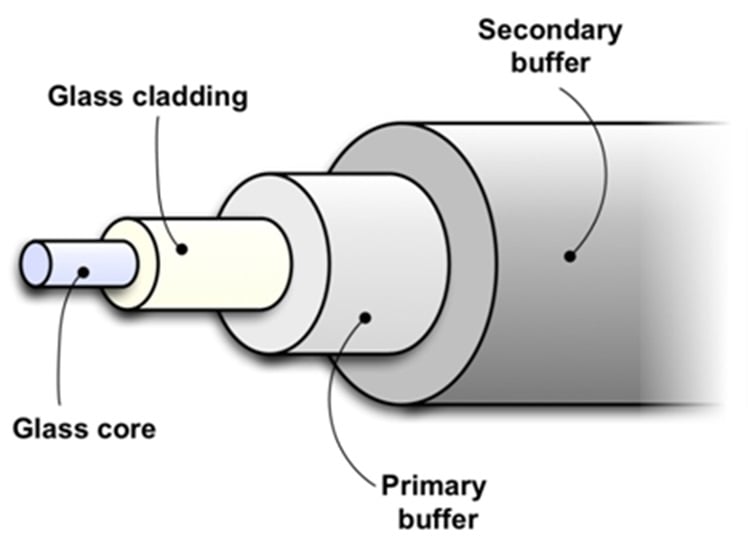
Instead of transmitting data electrically through copper cables like ethernet, fiber optic cables use beams of light to transfer data; therefore, the anatomy of a fiber optic cable is quite different. At the core of every cable is a thin fiber of glass about the width of your hair. This glass is used to transmit infrared light from one end of the cable to the other. Light is, in fact, part of the electromagnetic spectrum, which classifies how energy is emitted in “waves-like patterns.” On this spectrum is radio waves which are low energy waves that occur at the repeated frequency of every 50 miles or about 80,000 meters. Whereas on the other end of the spectrum, we have gamma waves that emit such powerful energy (how else do you think Bruce Banner could become the Hulk?) that they occur at the frequency of less than .01 of a nanometer. Infrared produces enough energy to operate at a wavelength of 850 or 1300 or 1550 nanometers. This is determined to be the ideal length of energy to facilitate a reliable transfer of data at high speeds. To protect the transfer of infrared light, the thin strand of glass, also known as the core, can be covered with a cladding layer that can be another layer of glass or plastic functioning as a barrier to help contain the light. Other layers known as buffers can be used to protect the cladding from moisture, bending, and damage.
Single-mode vs. Multimode Fiber Signal
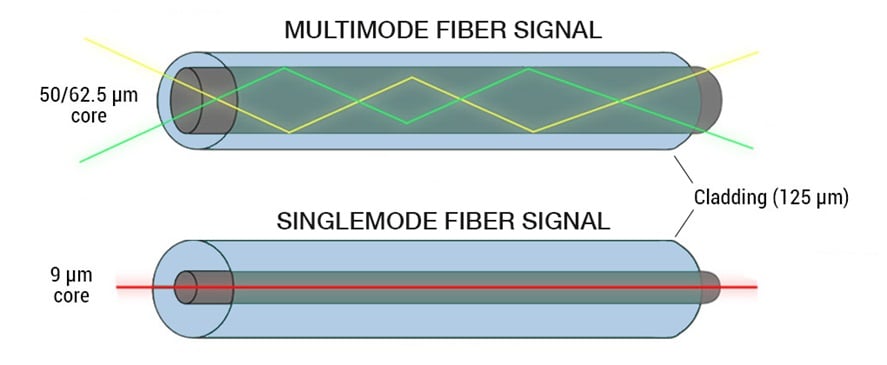
Fiber connections that you will find on the field will generally be categorized into two types: single-mode and multimode. A single-mode cable transfers light at 1310 and 1550 nanometers through a smaller core about the size of 8 to 10 microns. A single light is emitted directly through the beginning of its journey until it is terminated. Single-mode cables can be reliably used across distances of a mile, making it a viable option to connect networking devices directly and effectively to buildings spanning great lengths. Multimode cables, on the other hand, transfer light at 850 and 1300 nanometers through a significantly larger core at 50 or 62.5 microns. Instead of passing light through a straight line, multimode cables bounce light in the core and, due to this design, tend to be used for shorter distances. As the name would suggest, multiple modes of light are allowed to be emitted and travel through the cable. In the past, multimode was the fiber of choice due to its cost-effectiveness; however, nowadays, single-mode cables may be preferred due to their lower price and ability to travel further distances. If you find yourself in a situation of having to mix multimode and single-mode cables, then you do have the option of using a Fiber convertor. The convertor would take the light signals from a particular mode, covert the data into electrical signals, and send the data out through light signals compatible with the other mode. When working with fiber, it is imperative to ask, “is this multimode or single-mode?” and go beyond that. It is essential to know the micron’s diameter as a mismatch in size will undoubtedly result in a loss of data.
The Right Patch Cable
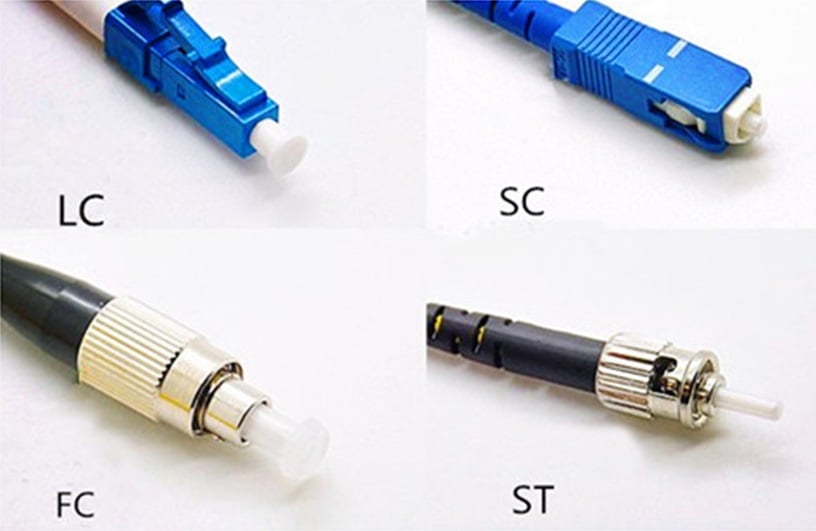
Ethernet cable jacks are all the same size, which is convenient because, at the very least, you know that cable jack is physically compatible with any device. With fiber, you might show up at a location with a fiber patch cable with the correct mode and diameter only to realize you have the wrong connector. Like ethernet, fiber tends to terminate into a fiber patch panel, requiring you to have either an SC, FC, ST, LC, MPO, or MT-RJ connector. Once connected to the patch panel, you must determine the transceiver’s connection type, which is connected to the networking device. It can be more than likely that you need LC on one end and SC on the other. It is worth noting that the newer OM5 cables are backward compatible with OM4. OM4 cables are backward compatible with OM3 and OM2. OM3 cables are backward compatible with OM2.
Types of Patch Cables
When trying to purchase the correct multimode or single-mode patch cable, you’ll notice that fiber cables tend to be branded as different types. Multimode consists of OM1, OM2, OM3, OM4, OM5. OM1 and OM2 are considered legacy now and surprisingly use LED light sources to transfer data. Both support up to 10 gigabytes in speed; however, OM1 has a core size of 62.6 microns and can travel close to 100 feet. OM2 cables have a core size of 50 microns and can span close to 250 feet. OM3 and OM4 cables have a core size of 50 microns. OM3 can reach speeds up to 100 gigabytes; however, according to FS, 10 gigabytes is the most common speed used, and it can reach a little short of 1000 feet. OM4 can reach close to double the distance of OM3 at a speed of 10 gigabytes. With an MPO connector, OM4 cables can also be used at a speed of 100 gigabytes, with a tradeoff of reaching a maximum of 410 feet. As the newest among multimode cables, OM5 has a core size of 50 microns. It implements a design that uses a pair of parallel fibers and multiplexing technology, allowing it to transfer 100 gigabytes up to 492 feet.
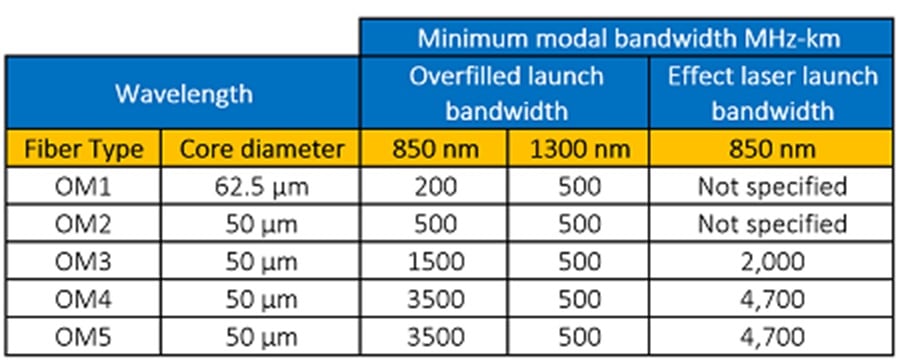
Single-mode cables consist of OS1 and OS2. OS1 cables tend to be used indoors and can run up to a little more than 6 miles. This single-mode can be purchased with a core of 9 microns and can reach speeds of 10 gigabytes. OS2 cables can also be obtained with a core 9 microns tend to be used outdoors. They can travel a distance upwards of 100 miles with a transfer speed of 10 gigabytes.
Transceivers
You can connect one end to a patch panel port and the other end to your networking device with an ethernet cable. Using fiber optics will require you to consider how to connect directly to your networking device. Infrared signals will need to be converted into electrical signals to be understood by networking equipment. Depending on the patch cables that are purchased, transceivers can be attached to the cable, allowing them to be plugged directly into network devices. Subject to your networking device manufacturer, you will need to purchase a transceiver module such as the small form-factor pluggable transceiver or SFP transceiver. This means that to use fiber with a conventional Extreme switch, you would first need to make sure it has a small form-factor pluggable or SFP port. You would then want to consider if your device can support an SFP module that operates at 1-gigabyte speeds or an SFP+ module that can operate at 10-gigabyte speeds.
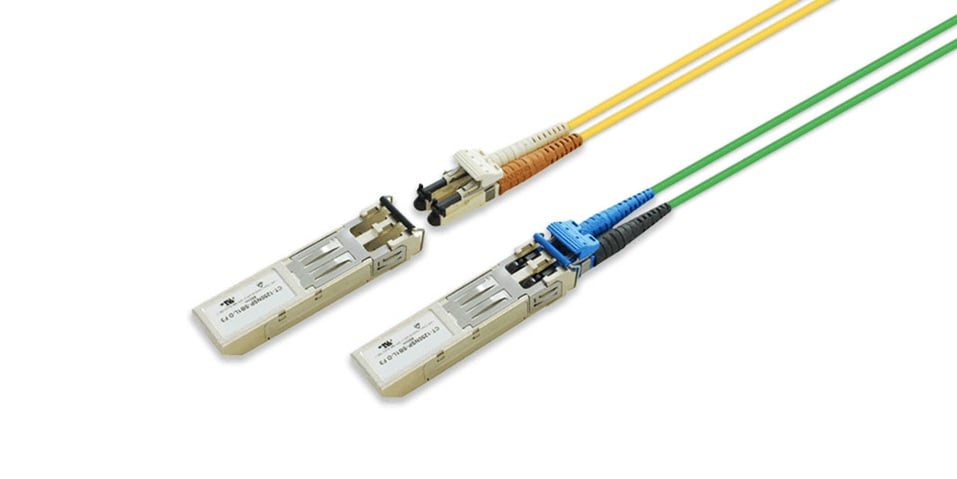
Caution
It cannot be stressed enough to those who’ve started working with fiber that they should never look directly into a transceiver or fiber in production. Infrared lights can cause eye damage and loss of clarity in vision. The Fiber Optic Association recommends using a pair of fiber optic safety goggles as infrared lights emanate out in a cone shape. Regarding handling patch cables, technicians should note that the ends of fiber cables are sensitive and should handle them with care. Since we’re working with a core around or even smaller than the size of a hair, it’s not hard to imagine the size in scale to a speck of dust. Particles in the air can block light travel and cause data loss. It’s always a good idea to keep a clean dust cap on patch cables and transceivers when they are not being used. Cisco has a great article on inspecting and cleaning fiber connections: https://www.cisco.com/c/en/us/support/docs/optical/synchronous-digital-hierarchy-sdh/51834-cleanfiber2.html
Conclusion
Due to its ability to travel great distances and transfer data at such high speeds, fiber can meet datacenter and organizational needs in a manner that ethernet has not been able to. The cost of implementing fiber has steadily been going down, and it should come as no surprise that fiber is more accessible than ever. Although fiber can appear daunting, it simply needs to be approached differently.
Once familiar with fiber, a technician will ask:
- Are we working with single-mode or multimode?
- What type of connector will I need for both ends of my patch cable?
- What micron size should the core of the cable be, and which path cable should I use?
- Will I need to purchase a transceiver? If so, which one?
- Am I working with clean equipment?
There’s still more information to cover regarding fiber; however, we hope this primer could provide you with enough knowledge to demystify the subject and make tackling it more approachable.
Sources:
- https://imagine.gsfc.nasa.gov/science/toolbox/emspectrum1.html
- https://www.cablinginstall.com/design-install/cabling-design/article/16480159/three-reasons-not-to-mix-50-and-625micron-multimode-fibers
- https://www.thefoa.org/tech/ref/basic/fiber.html
- https://www.thefoa.org/Lennie/jargon.html
- https://www.livescience.com/50399-radio-waves.html
- https://www.britannica.com/science/infrared-radiation
As a Managed Service Provider (MSP) and Managed Security Services Provider (MSSP), we manage your IT services, offer backup and disaster recovery, and provide network visibility and security. Our knowledgeable and customer-oriented staff engages to accelerate your network and simplify its security, visibility and automation. Questions? Contact Tec-Refresh, Inc.
